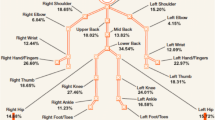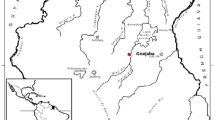Abstract
Musculoskeletal (MSK) pain poses a major burden on individuals and health care systems. Assessing its pervasive impact has broadened the horizon of treatment strategies. The aim of this study was to determine the prevalence of MSK pain and its relationship with the health-related quality of life (HRQL) in a rural community. Individuals (>15 years) with MSK pain were identified by house–house survey from a population of 6,763 individuals. HRQL was assessed using the validated ‘Modified Indian HAQ (CRD – Pune)’, translated into regional language. Moderate and severe health assessment questionnaire disability index (HAQ-DI) scores were considered significant. Details regarding the impact of pain on their personal, family and social life were also studied. All individuals with MSK pain were evaluated clinically by a medical team and HAQ-DI was compared in different groups of disorders. Prevalence of MSK pain in the community (mean age, 52 ± 15.8 years) was 26.08% (95% CI 25.03–27.13). About 8% of the respondents reporting MSK pain had to stop work and 4% had chronic depression. A significant HAQ-DI was scored by 31% subjects. Level of education and intensity of work had significant associations with HRQL. Among the clinical diagnoses, non-specific MSK pain also scored a high HAQ-DI. MSK pain, both due to specific and non-specific disorders, showed an important impact on HRQL in this community study. Combined with ascertainment of risk factors and associations, this has implications on planning treatment and prevention. We plan to continue using HAQ in time to monitor the community.




Similar content being viewed by others
References
Woolf AD, Pfleger B (2003) Burden of major musculoskeletal conditions. Bulletin of the World Health Organisation 81:646–656
Chopra A (2004) COPCORD—an unrecognised fountainhead of community rheumatology in developing countries. J Rheumatol 31:2320–2322
Chopra A, Abdel-Nasser A (2008) Epidemiology of rheumatic musculoskeletal disorders in the developing world. Best Pract Res Clin Rheumatol 22:583–604
Brage S, Nygard JF, Tellnes G (1998) The gender gap in musculoskeletal-related long-term sickness absence in Norway. Scand J Soc Med 26:34–43
Joshi VL, Chopra A (2009) Is there an urban-rural divide? Population surveys of rheumatic musculoskeletal disorders in the Pune region of India using the COPCORD Bhigwan model. J Rheumatol 36:614–622
Chopra A, Saluja M, Patil J, Tandale H (2002) Pain and disability, perceptions and beliefs of a rural Indian population: a WHO-ILAR COPCORD Study. J Rheumatol 29:614–621
Scott D, Garrod T (2000) Quality of life measures: use and abuse. Baillieres Best Pract Res Clin Rheumatol 14:663–687
Roux C, Guillemin F, Boini S et al (2005) Impact of musculoskeletal disorders on quality of life: an inception cohort study. Ann Rheum Dis 64:606–611
Aggarwal A, Chandran S, Misra R (2006) Physical, psychosocial and economic impact of rheumatoid arthritis: a pilot study of patients seen at a tertiary care referral centre. Natl Med J India 19:187–191
Cella D, Yount S, Sorensen M, Chartash E, Sengupta N, Grober J (2005) Validation of the functional assessment of chronic illness therapy fatigue scale relative to other instrumentation in patients with rheumatoid arthritis. J Rheumatol 32:811–819
Wolfe F (1999) Determinants of WOMAC function, pain and stiffness scores: evidence for the role of low back pain, symptom counts, fatigue and depression in osteoarthritis, rheumatoid arthritis and fibromyalgia. Rheumatology 38:355–361
Chopra A, Lavin P, Patwardhan B, Chitre D (2000) Randomized double blind trial of an Ayurvedic plant derived formulation for treatment of rheumatoid arthritis. J Rheumatol 27:1365–1372
Appendix I. In: Klippel JH, editor. Primer on the rheumatic diseases. 11th ed. Atlanta: Arthritis Foundation; 1997:453–64.
http://www.rheumatologyindia.org/pdf/HAQ.pdf (accessed 14th July 2010)
Pincus T, Summey JA, Soraci SA Jr, Wallston KA, Hummon NP (1983) Assessment of patient satisfaction in activities of daily living using a modified Stanford Health Assessment Questionnaire. Arthritis Rheum 26:1346–1353
Chopra A (2009) Community rheumatology in India. Ind J Rheumatol 4:119–126
Muirden KD (2005) Community oriented programme for the control of rheumatic diseases: studies of rheumatic diseases in the developing world. Curr Opin Rheumatol 17:153–156
Alonso J, Ferrer M, Gandek B et al (2004) Health-related quality of life associated with chronic conditions in eight countries: results from the International Quality of Life Assessment (IQOLA) Project. Qual Life Res 13:283–298
Veale DJ, Woolf AD, Carr AJ (2008) Chronic musculoskeletal pain and arthritis: impact, attitudes and perceptions. Ir Med J 101:208–210
Picavet HS, Hoeymans N (2004) Health related quality of life in multiple musculoskeletal diseases: SF-36 and EQ-5D in the DMC3 study. Ann Rheum Dis 63:723–729
Antonopoulou MD, Alegakis AK, Hadjipavlou AG, Lionis CD (2009) Studying the association between musculoskeletal disorders, quality of life and mental health. A primary care pilot study in rural Crete, Greece. BMC Musculoskelet Disord 10:143
Acknowledgements
This project was funded by the Bone and Joint Decade - India. Volunteer health workers from the community helped in the door-door survey in phases I and II. Drs. Jacob Antony, Nevine Anandam and Gopakumar Sreekumaran Nair helped in phase III rheumatology clinics. Dr V Rajamani acted as a referee for this project. The late Dr C R Soman, played an instrumental role during the conceptional stages of this study. Health Action by People, Trivandrum, helped with laboratory services and logistics support. The authors wish to thank the local residents of the community and the local administration for their whole hearted support and co-operation during the period of the project.
Disclosures
None.
Author information
Authors and Affiliations
Consortia
Corresponding author
Rights and permissions
About this article
Cite this article
Mathew, A.J., Chopra, A., Thekkemuriyil, D.V. et al. Impact of musculoskeletal pain on physical function and health-related quality of life in a rural community in south India: A WHO-ILAR-COPCORD-BJD India Study. Clin Rheumatol 30, 1491–1497 (2011). https://doi.org/10.1007/s10067-011-1824-0
Received:
Revised:
Accepted:
Published:
Issue Date:
DOI: https://doi.org/10.1007/s10067-011-1824-0




